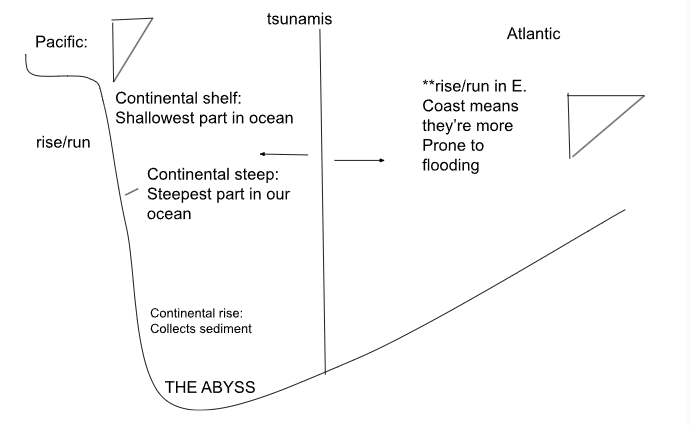Geological Oceonagraphy
71% of the earth is covered by water
- N. Hemisphere ~ 60%
- S. Hemisphere ~ 81%
Oceans are the main source of saltwater
- 5 oceans that scientists identified but refer to as the main bodies that create waves, currents, and other ocean phenomena
- Pacific, Atlantic, Indian, Southern, Arctic
- Out of the 5, the Southern is the newest, relatively identified
- Pacific is the largest/deepest
- Atlantic is the second largest, and the smallest is the Arctic. The Southern Ocean is the second smallest
Earth is created based on density
- Density: how much something weighs in a particular area
- The more weight is spread out, the easier it is to manage
- Ex) An 80-pound cell phone versus an 80-pound ceiling. You can hold up the latter in one hand
\
- Oceanic Crust (Oceanic plates/Continental plates)
- Younger, thinner, but extremely heavy
\
- Continental crust
- Older, thicker, but lighter
Both of them are lighter than the mantle
Diverging plates vs Converging plates
- Diverging plates:
- Move away from each other
- Forms mid-ocean ridge
- Big crack in the Atlantic Ocean, from the N. Pole to S. Pole, the only part of Earth where new land is being formed constantly is in the Atlantic Ocean
- Convergent plates:
- 2 oceanic crusts form a subduction zone
- Deep sea trench
- Lots of lifeforms in these environments are undiscovered
Subduction zones: The region where an oceanic plate sinks down into the asthenosphere at a convergent boundary, between continental and oceanic plates
Hydrothermal vents:
- Organisms are constantly being found and identified in the hydrothermal vents, they’re a land of their own
- Lots of bacteria and fish
The Pacific Ocean has converging plates, the Atlantic Ocean has diverging

Further elaboration: You can walk around 100 yards in the Atlantic Ocean on the East Coast and still be only ankle high. However, if you take a few steps in the Pacific, you’ll be met with a steep drop because there is only a tiny portion of the water is shallow
Earthquake activity is increased towards the Pacific, a tsunami is formed by earthquakes, and there’s more earthquake activity there
A huge amount of energy in a small space increases its pressure. The pressure creates a massive tsunami, and the drastic change of slope forces the water to be pressurized
- Earthquakes have to happen in the open ocean